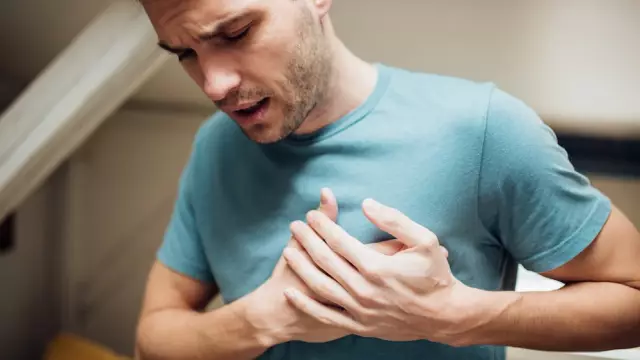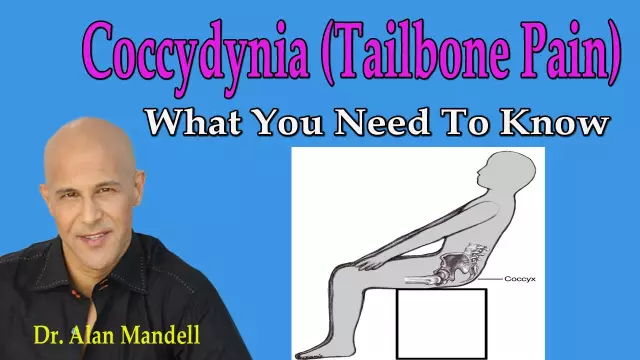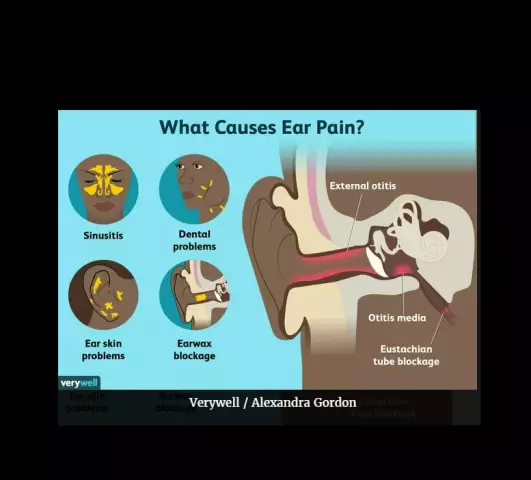- Author Rachel Wainwright [email protected].
- Public 2023-12-15 07:39.
- Last modified 2025-11-02 20:14.
Causes of chest pain

Chest pains can be different in duration, intensity, nature, time of onset, frequency. In addition, there may be right or left chest pains, or they can be extensive. It all depends on the reasons causing them.
The following are the most common causes of chest pain.
Chest pain due to heart problems
Angina pectoris is a fairly common cause of chest pain on the left. Angina pectoris, or, as it is also called, angina pectoris, causes paroxysmal pain resulting from coronary insufficiency, when the heart muscle suffers from hypoxia. Hypoxia of the heart muscle occurs due to atherosclerosis or spasm of the coronary vessels.
With angina pectoris, there is a prolonged aching pain on the left side, which can spread to the neck, lower jaw and left arm. Often, pain occurs in the epigastric region and spreads to the area of the left scapula. With angina pectoris, chest pain is easily relieved with validol or nitroglycerin. If pain occurs after intense physical activity, it is often enough to simply rest for five minutes to stop it. Doctors distinguish between intense angina pectoris and rest angina. If you first have pain in the chest on the left, you need to know the following nuances:
- It is necessary to take validol or nitroglycerin as soon as possible;
- If chest pain persists after five minutes, nitroglycerin should be re-taken;
- If the pain persists after another 15 minutes, you need to call an ambulance. If the attack lasts longer than half an hour, the heart muscle begins to experience acute hypoxia, which can cause acute myocardial infarction.
Chest pain can also be caused by acute myocardial infarction. In this case, the pains are intolerable and can even cause painful shock. Immediately at the time of myocardial infarction, patients compare the pain sensation with a dagger strike. Pains are accompanied by severe sweating and pallor, a decrease in blood pressure, fear.
In addition, chest pains on the left can occur with heart defects, paroxysmal arrhythmias, pulmonary embolism, aortic aneurysm, etc.
Chest pain due to trauma
Such pains can be different both in nature and in localization. As a rule, traumatic pains are aggravated by tilting the body, breathing, and coughing.

If pain occurs, an urgent need to consult a doctor. For what? The doctor decides at once several vital issues for the patient, namely:
- whether there is a bruise of the lung and heart;
- Are the spine and ribs damaged?
- is there a blunt trauma to the soft tissues of the chest;
- whether the pleural cavity is damaged, whether pneumothorax develops;
- whether there are signs of accumulation of blood or fluid in the pleural cavity.
The nature of the treatment of chest pain directly depends on all these nuances.
It is important for patients to know that a variety of bruises and injuries to the chest may seem minor at first, but over time lead to an increase in complications and pain. Therefore, do not postpone a visit to the doctor. Often, patients are already dealing with long-term pain syndromes, which significantly interferes with doctors in providing adequate medical care.
Chest pain with pneumonia
Pain with pneumonia is easy to recognize, as it usually begins with a dry cough, which after a few days turns into a cough with sputum production. In addition, such pains are usually accompanied by symptoms of the body that arise in response to inflammatory processes: shortness of breath, high body temperature, increased sweating, etc.
Retrosternal pain can also occur with pleurisy. The pleura is the pulmonary membrane in which many nerve endings are present. Dry pleurisy can cause stabbing pain when coughing or exhaling. Such pains are localized at the site of the inflammatory focus. So, such pains can be observed in the chest on the right or on the left, but most often in the lower-lateral region of the chest. Exudative pleurisy with the formation of fluid in the pleural cavity is accompanied by more intense pain and coughing and is often combined with severe shortness of breath.
Emphysema of the lungs - bullous expansion of the alveoli of the lungs with loss of tissue elasticity. Often emphysema develops after various lung diseases, it is a complication of heart defects, pneumosclerosis or some occupational diseases (for example, in miners). Respiratory failure and a barrel chest are always companions to emphysema. Chest pains with emphysema are aching in nature and are localized between the ribs.
Diaphragmatic hernia
A diaphragmatic hernia may be the cause of chest pain. In this case, the patient feels a burning sensation in the lower part of the sternum and retrosternal space. Burning pain is often combined with belching. A similar burning sensation is caused by irritation of the mucous membrane of the esophagus by the gastric acidic environment. Pain in diaphragmatic hernia directly depends on food intake.
Pain in diseases of the spine
With scoliosis, pain in the thoracic spine often occurs. This disease is also characterized by neurological pain and pain in the muscles of the trunk.
Another disease in which chest pains can occur is Scheuermann-Mau disease. This disease is characterized by wedge-shaped deformation of several vertebrae of the thoracic spine, which leads to the formation of a hump. With this disease, the patient experiences aching pain in the muscles of the back and pain of a neurological nature, arising from the infringement of the spinal roots in the zone of deformation of the vertebrae.
Bechterew's disease, or deforming spondyloarthrosis. The pains in this disease are aching in nature and are common throughout the spine. They are caused by the inflammatory process in the joints. This disease is also characterized by a feeling of stiffness in the joints, especially in the morning. However, the main symptom of spondyloarthrosis is not pain, but slowly developing stiffness in the joints of the spine.
Osteoporosis is a disease characterized by a deficiency of calcium in the bones, since there is a violation of the processes of calcium resorption in bone tissues. This disease is characterized by pain in the chest on the right and left, often worsening after significant physical exertion. More often, such pains are localized in the lumbar and pelvic spine, and in the chest they occur mainly during a generalized process.
Found a mistake in the text? Select it and press Ctrl + Enter.






